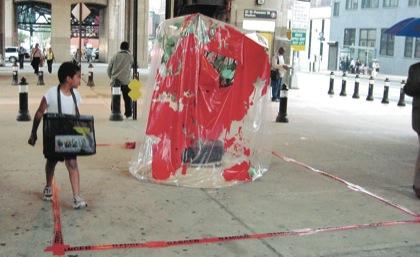BY CONNOR ADAMS SHEETS
A recent panel discussion at the Crossing Art gallery at the Queens Crossing shopping area in Flushing brought hope and inspiration to a crowd of artists and professionals interested in the craft of public art and its place in Queens.
The sphere of public art is quite limited in Queens, according to several arts representatives in attendance, but there is a fledgling group of people working to bring the form to the borough.
“There’s less public art going on in Queens than in Brooklyn or Manhattan,” said Hoong Yee Lee Krakauer, executive director of the Queens Council on the Arts, which organized last Thursday’s event. “It’s an abysmal amount of public art going on in Queens.”
But in recent years a number of Queens public art projects have drawn a mixture of praise and controversy from residents.
Public art, which ranges from sculpture installations to graffiti and from art interventions to the internationally known Christo and Jeanne-Claude exhibit “The Gates,” which was in place in Central Park for 16 days in winter 2005, is a commonly misunderstood form.
Examples of well-known public art pieces in Queens include “100 Degrees,” created by two of the panelists — new media artist Hector Canonage and media artist Chih Chih Yang — which was installed in a Long Island City subway station in June and destroyed by vandals six days later. Another is Nancy Chun’s Queens-themed mural “Mapping Queens” at IS 125 in Woodside.
The conversation was aimed at clarifying some common misconceptions while raising awareness of public art, the challenges it faces and the purposes it may or may not serve.
The speakers, which included artists, consultants and a city arts representative, had varying definitions of public art, but they agreed it is an important part of the arts community in New York City.
“When there’s a response to the imbedded message of the piece from the audience … for me that is a success,” said Canonage, offering a characterization that most public artists generally agree with.
Despite the intense connections to their works, the challenges that face public artists in Queens and elsewhere were a large concern throughout the artist’s conversations.
One of the panelists, a renowned graffiti artist as well as a more mainstream public artist and author, identified himself as Alan Ket since he said he has been prosecuted for graffiti-related crimes and now has a criminal record.
“I’ve painted at least 1,000 subway trains throughout my career, but I’ve never asked the MTA for permission,” Ket said. “Myself and my peers in this street art just go out and do it, we don’t really care about art administrators or bureaucracy.”
So why pursue public art in a city that often seems bent on stopping some of the most provocative works being produced?
Yang said it is because there is an emotion inside him that he can only release through his public expression.
“My friend told me, ‘Why do you do that? You have two kids, you have a family,’” he said. “But if I don’t do it now, the time will pass …. It’s important to me as an artist that I do it.”
Reach reporter Connor Adams Sheets by e-mail at csheets@cnglocal.com or by phone at 718-229-0300, Ext. 138.






























